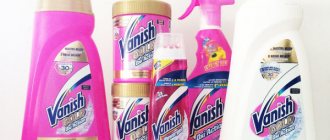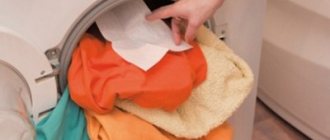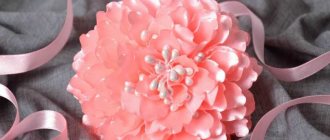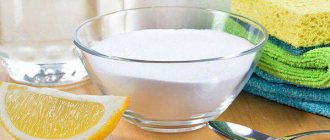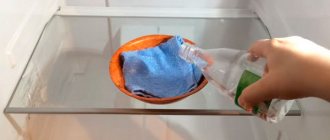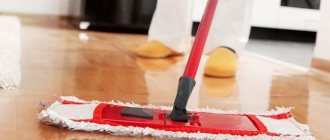Every housewife sometimes faces the challenge of urgently needing to remove a stain on clothing or restore a damaged item to its original appearance. Many people don’t even realize that you can easily make an effective stain remover with your own hands from home remedies that are always available in the kitchen.
We invite you to get acquainted with simple but effective recipes that can replace expensive household chemicals. It is important to remember that stain removers are divided into oxygen, acid, solvent and targeted agents. Which one to choose depends on the origin of the stain and the type of fabric.
Oxygen analogs include: hydrogen peroxide, borax, soda ash and baking soda; acidic substitutes include table vinegar, citric acid; ammonia, olive oil, and acetone will serve as solvents. Laundry soap, glycerin, salt, green tea, olive oil and aspirin are always in demand when cleaning things.
First steps to neutralize the stain
If there is contamination and there is no chance of washing the soiled clothes immediately:
- it is blotted with a damp cloth;
- moisten the stain with carbonated mineral water;
- if grease is splashed onto clothes, moisten the stain with dishwashing detergent;
- if there is nothing at hand, wash the stain with cool water, not allowing it to be absorbed;
- old stains are soaked in warm glycerin and washed off when appropriate.
Attention!
Stains cannot be removed with a dry cloth or rag; they will be rubbed into the fabric.
Before using a homemade stain remover, first read the information about the type of material and check its reaction on a piece of fabric that is sewn from the inside out. Then:
- Cleaning the stain begins from the wrong side, placing a clean cloth under the item;
- remove the stain, moving from the edges to the center;
- Around the stain, the fabric is moistened with water and talc or starch is sprinkled; such an obstacle will prevent the stain from spreading.
What not to do when removing a wine stain
To avoid making the problem worse, it is important to understand what not to do.
- When washing, try to wash from the edges to the center. Otherwise, the stain will “hiss.”
- Please note that strong detergents should not be used on wool and natural furs. Choose a gentle solution
- When treating a stained area, you must ensure that there are no streaks left around the stain. To prevent this, you must first wet the area around the stain with clean water.
If you follow proper cleaning procedures, the results can be impressive. Don't rush to throw away your stained sweatshirt. No matter how difficult the stain is, there is always a way to get rid of it.
Preparing stain remover for colored fabrics
It’s a pity to throw away a favorite but soiled item, so it’s possible to bring it back to life with the help of laundry soap and soda. For colored items you will need:
- 500 ml water;
- 25 g of finely grated laundry soap;
- 75 ml green tea infusion;
- 50 g soda ash.
Pour water into the pan, put it on gas and heat it to a boil, then:
- Add grated soap to hot water and constantly stir the solution to dissolve the soap pieces.
- After the chips are completely dissolved, add soda while stirring and pour out the green tea.
- Remove the pan from the heat and cool.
- Place the soiled laundry into the drum of the washing machine, pour out the prepared bleach, and wash using the normal cycle. This product is natural and harmless to tissue and humans.
DIY baby laundry detergent - recipe No. 3
A mixture that includes borax (sodium borate) is a good cleanser because this natural substance has antibacterial and antifungal properties. It is not for nothing that borax is added to baby powders, as it has the ability to cope with severe dirt and soften fabrics.
Warning: Sodium borate is alkali, so protect your hands by wearing rubber gloves. You can buy it at hardware stores.
Includes:
- dark laundry soap – 150 g;
- baking soda – 500 g;
- borax – 200 g;
- a few drops of essential oil (tea tree).
Three soaps on a fine grater. Combine a small amount of boiling water, add all the other ingredients, stir and use instead of regular washing powder. You will definitely be pleased with the quality of the wash. But also keep in mind that borax has a bleaching property and is not suitable for washing colored items.
3 ways to put your old jacket to good use
Help for white tissues
To prepare stain remover at home you will need:
- 100 ml hot water;
- 50 ml hydrogen peroxide;
- 50 g baking soda.
Cleaning steps:
- Hot water is poured into the container.
- Add ingredients and mix.
- Pour into a spray bottle.
- Spray the stain and leave for 10-15 minutes.
- They wash it.
- For an old stain, leave the mixture of products on the clothes for up to 8 hours, then wash.
If you need to remove dirty stains left by non-grease, then several more methods will do. First recipe:
- white socks or towels are soaped with laundry soap and left for 30 minutes;
- wash;
- soak in cold water with the addition of citric acid overnight;
- rinse in the morning.
Varieties and methods of replacing them
The choice of stain remover depends on the composition of the stain. The principle of action is to destroy an organic or inorganic compound and remove it from the tissue.
Chlorine
Chlorine-containing compounds, for example, Whiteness, are used to bleach white cotton and linen items. At home, it can be replaced with a bleach solution. 30 grams per 1000 milliliters is enough.
Using a home stain remover has the same limitations and disadvantages as the professional method:
- premature wear of the fabric;
- yellowness on a white background;
- toxicity of odor and solution;
- use on fabrics with a dense, natural structure.
The use of chlorine compounds requires skin protection and ventilation.
Peroxide
Special stain removers contain oxygen, which oxidizes the organic components of the stain. At home, a substitute for store-bought stain remover would be hydrogen peroxide and soda ash. A pharmaceutical disinfectant will also replace chlorine-based bleach.
Perhydrol, when interacting with water, breaks down into oxygen and carbon dioxide. Soda ash softens the water, making the fabric easier to clean. For greater effect, the water temperature should be 70-80 degrees. For silk and wool, the temperature is reduced to 30-50 degrees. Homemade stain remover is not used for cleaning colored fabrics. Chemicals require careful handling to avoid contact with mucous membranes and the gastrointestinal tract.
See also
How to remove dandelions from clothes, top 17 ways at home
Acid
Professional stain removers contain oxalic and hydrofluoric acids. They are used to remove iron oxides from cotton items. High toxicity and aggressiveness limits their use.
Table vinegar, artificial citric acid, and lemon juice have similar qualities in terms of interaction with inorganic substances.
Stain remover for various types of stains
Fresh stains can be removed using a homemade stain remover. For this you will need:
- detergent;
- hydrogen peroxide;
- baking soda.
Mix in a container:
- 1 tsp detergent;
- 2 tbsp. peroxides;
- ½ tsp. soda;
- Apply the mixture to the stained areas, leave for 15-20 minutes, then wash the item as usual.
There are different types of stains that require a special approach:
- Green grass stains. Contaminants are removed by dissolving 1 tsp in half a glass of warm water. salt. The solution is applied to the problem area, then the product is rinsed. Dirt is removed from white things using a mixture of hydrogen peroxide and ammonia.
- Stains from eau de toilette and perfume. The contaminated area is lightly rubbed with wine vinegar, then wiped with a cotton pad with acetone applied to it. When working with colored fabrics, the effect of the preparations is checked in an inconspicuous place to avoid washing off the paint in the problem area.
- Stains from coffee and tea. Freshly spilled coffee on clothes is blotted with a napkin and neutralized using finely ground salt, which is thickly sprinkled on the damaged area. Next, the item is machine washed. A homemade stain remover for such cases is prepared as follows: add 3 tbsp to 1000 ml of water. ammonia, 1 tsp. dishwashing detergent, 1 tbsp. vinegar, leave for 15-20 minutes. Then the product is washed and rinsed. The same product helps in the fight against traces of foundation and other cosmetics on clothes.
- Concealer marks. Fresh traces of corrector can be easily washed off with laundry soap, shampoo or detergent. Dried marks are wiped off with a cotton swab soaked in vodka to remove makeup.
Cosmetics
Lipstick, foundation, powder, mascara - all these marks can sometimes remain on clothes, so you need to know how to deal with them. Lipstick can be easily removed by spraying the mark with hairspray and then simply washing the item. Foundation or powder often stain the collars of blouses, but these stains can be easily removed with a cotton pad soaked in ammonia.
Traces from deodorant sometimes become a real disaster - it leaves white or yellow spots on clothes, and this is noticeable on both colored clothes and light ones.
In the first case, stains are removed with a mixture of salt (1 tsp) and ammonia (1 tsp). The mixture should remain on the surface of the stain for about 15 minutes, then the clothing is rinsed with water. In the second case, a mass prepared from cold water and baking soda will help; the substance is applied to the stain for 30 minutes, then washed off with warm water.
Blots from ink and ballpoint pen paste
Before starting work, place paper under the fabric with talcum powder or starch sprinkled on it. They powders will partially absorb the ink, preventing it from spreading further. Help in the fight against blots:
- Ethyl alcohol + glycerin, taken 1 to 1, wipes off ink dirt in 5-10 minutes;
- Milk. The contaminated area is wiped with warm milk.
- Vinegar + ethyl alcohol. The preparations mixed in equal parts can deal with the stain in 5 minutes.
- Mustard. Apply a paste of water and mustard to the stained areas and leave for a day.
- Baking soda + turpentine. Mixed in equal proportions and applied to dirty parts of clothing, removes stains within 15 minutes.
- Salt and citric acid. The stained area is sprinkled thickly with salt and wiped with a slice of lemon or a cotton swab soaked in citric acid.
- Acetone. Blots are removed using a cotton pad soaked in acetone. Wipe the stained area, starting from the edges to the middle. The product is then washed as usual.
Attention!
Fresh blots are easier to remove than old ones
Stain remover from felt-tip pen and marker
Since the ink component of these writing instruments does not include an oil base, it quickly penetrates into the fabric and is less easy to clean than ballpoint paste. Dirt from drips and blots on clothes left by a marker can be removed using:
- lubricating the stain with lemon juice and then washing the product;
- washing the blotted area with laundry soap;
- wiping stains with a cotton pad soaked in hydrogen peroxide;
- treating the dirty area with a solution consisting of a glass of water and 1 tbsp of ammonia;
- wiping the blot with a cotton pad soaked in kefir.
Adviсe
Helpful information:
- When you begin the process of removing wine stains, you need to take precautions, such as protecting your hands with gloves.
- When removing a wine stain, work from the center of the stain outward.
- Before attempting to remove a stain with a new cleaner, test it on a small area of fabric.
- Drink wine only from wine glasses. This will make it less likely that you will spill it. For example, it’s not for nothing that a large number of different glasses for cocktails were invented. What would be convenient to drink!
- If you are using an odorous substance, such as ammonia, make sure the area is well ventilated and place a mask over your mouth and nose.
Removing stains from sweat and deodorant
Yellow stains on white blouses and T-shirts under the arms can be removed with a wonderful homemade stain remover. It is suitable for washing clothes, washing dishes, and cleaning sinks and bathtubs. Dissolve 90 g of baby anti-stain soap “Eared Nanny” in 3 liters of hot water while stirring. Add 90 g of soda ash and remove from heat. Leave until completely cool. The resulting gel is whipped and poured into jars or plastic bottles. A little product is applied to the areas of clothing under the arms and left for 2-3 hours. Then the product is washed as usual. If the stains are strong, leave the product on the clothes overnight.
If the item is colored, wash it by hand by adding 1 tsp of ammonia to 1 liter of water, or remove stains by wiping with a sponge soaked in a strong saline solution. If the methods do not help, turn to stain removers for white fabrics for help, but act carefully, checking the integrity of the staining.
Non-standard approach: 5 methods
If you can’t remove a greasy oil stain on clothes or home textiles using traditional means, you can experiment with non-standard methods. Five remedies are of greatest interest.
- Carbonated drinks. Coca-Cola descales kettles, removes soap scum from plumbing fixtures, and even unclogs pipes. There will also be no trace left of a greasy stain on the fabric if you make a “compress” with soda for three hours. For white pants and shirts, it is better to use colorless Sprite.
- Bread. You can remove oil traces from velvet without damaging it using bread crumbs. Simply press a small piece of fresh produce onto the stained area so that the fat is absorbed into the bread.
- Mustard powder. If you are unable to remove an old grease stain from your clothes even after washing and ironing, try using mustard. Dilute the powder with water to form a paste-like substance and apply it to the fabric for half an hour.
- Shaving foam. To save a stained down jacket or bologna jacket, apply a little product to the stain and rub in. After five minutes, wipe the treated area with a sponge soaked in clean, warm water.
- Shampoo. Minor stains on delicate fabrics can be removed with a product for oily hair. Just apply the composition to the stain for five minutes, lightly rub and wash the product.
Colored stains from berries and fruits
To remove colored stains from berries, fruits and juice stains, several methods are used:
- Small stains from berries and fruits can be eliminated with water, dishwashing detergent and vinegar. Dissolve 1 tbsp of vinegar in 1 liter of water, add 1 tsp. dishwashing detergent, soak the item in the solution, leave for some time and wash.
- If streaks remain, stir 1 tsp. soda and 1 tsp. hydrogen peroxide and apply directly to the stain, rinse the product.
- Boiling water helps in the fight against colored stains from berries. The stained cloth is pulled over the pan and poured with boiling water from a kettle until the stain disappears or becomes lighter. Next, the item is washed using powder or laundry soap.
- Treat heels with ammonia. Use a cotton pad soaked in ammonia to wipe away stains and drips from juices.
- Kefir helps in the fight against fabric staining. The problem area is poured generously with kefir and left overnight. Lactic acid will discolor the stain.
Stain removers for white laundry
The best products for white things:
Bos Plus Maximum. The product is the most budget-friendly in the fight against stains. Used as a wash activator or stain remover. Gives whiteness to old or yellowed items. If the powder is used for colored fabrics, then it should be taken into account that things may fade. The main advantages of Bos Maximum: copes with many stains, whitens effectively, has a pleasant aroma, acts at 40 degrees Celsius, low cost. Disadvantages of the powder: although the manufacturer indicates on the packaging that Bos Plus Maximum can be used for colored fabrics, this is not recommended; the item may fade.- Laundry soap for children Eared nannies with whitening effect. This is an excellent product that helps fight even the oldest stains, drinks, watercolor marks and other stains. The manufacturer states that the soap is designed specifically for children's clothing, but the product works great on any fabric, even upholstery. The reviews say that laundry soap helps even in particularly advanced cases, but it should not be used for colored items, as they may fade. Pros: highly effective in fighting stains, whitens perfectly, pleasant aroma, gentle on the skin of the hands. Cons: not a very good stain remover for colored items, high consumption.
The most convenient to use
Many housewives want to purchase a stain remover that is not only effective, but also convenient and comfortable to use. These products include 2 products:
- Faberlic (Edelstar). This product is made in the form of a pencil. Faberlic (Edelstar) received a lot of positive feedback from housewives. The product can be used not only at home, it is very easy to use anywhere, to do this, you need to wet the stain with water, rub it with a pencil and leave for 10 minutes. The product copes well with traces of black tea, coffee, ballpoint pen and brilliant green. If there is old dirt on the clothes, the pencil will have to be used several times. Advantages of Faberlic (Edelstar): after using the pencil, clothes can be washed immediately in an automatic washing machine, has a targeted effect on dirt, is easy to use, guaranteed results. Disadvantages: the product is packaged in a paper wrapper, which must be peeled off before use; it may not work the first time.
- Amway PreWash Spray. The product is very convenient to use: you need to spray the spray onto the stain and then wash the item. The spray can is convenient to use not only at home, but also in other places, for example, the office or at work. Amway PreWash Spray consists of 30% non-ionic surfactants and does not contain any other components that destroy dirt. The spray works great on fresh stains, but may be powerless when dealing with old and stubborn stains. Advantages of the product: can be used for fresh stains without washing, has a targeted effect on dirt, is convenient to use outside the home. Disadvantages: Unpleasant odor, not effective on stubborn stains.
Blood trails
Blood stains are quite difficult to remove, since at high temperatures the blood protein is firmly embedded in the tissue, and it is impossible to get rid of the yellow stain.
Attention!
Clothes with blood stains are soaked in cold water as soon as possible. All manipulations are carried out later.
Helps get rid of stains:
- Soap. A blood-stained item is washed in cold water and laundry soap.
- Ammonia. After soaking the fabric in cold water and washing it, dilute 2 tablespoons of ammonia in 200 ml of water and soak the damaged item for several hours, then wash in warm water.
- Hydrogen peroxide. It helps in removing even old yellow stains.
3% hydrogen peroxide is poured onto the blood stains and the damaged area is scrubbed with a toothbrush. Next, the product is washed at low temperature. This method is not suitable for delicate fabrics (silk and nylon), as friction can ruin the structure of thin things.
- Soda. Dissolve 1 tbsp in 200 ml of water. l of soda and pour it onto the problem area. After 30-60 minutes, the product is washed in warm water.
- Starch. It is used for clothing made from delicate fabrics. Starch is diluted with water to a paste and applied to contaminated surfaces.
Stain remover for red wine stains
Wine is spilled on a festive dress or shirt at the most inopportune moment. Emergency measures to remove traces:
- Blot the red stain with a napkin.
- Then wipe with a slice of lemon.
- Apply a paste of finely ground salt to the fresh footprint. The salt will absorb the dyes, and shake it off with a dry cloth.
Old traces left by red wine are removed using:
- Ammonia. The tan is washed in water with the addition of ammonia (per 1 liter of water - 1 tablespoon of ammonia).
- Egg yolk and glycerin. The ingredients for the mixture are taken in equal parts, applied to the problem area and left for 2-3 hours. Then the washing is done.
How not to ruin fabric
You will find various recipes on the Internet that claim to help you remove wine stains from fabrics. However, not all of them can be applied in practice.
To avoid having to throw things away after such treatment, you should take into account the following tips:
- Cleaning with manganese dioxide. If you try to remove a stain with this product, it will simply turn black. After this type of flushing, you will need to find a way to remove the manganese dioxide itself.
- Rinse with sodium sulfite. This substance is an acid salt of sodium and sulfuric acid. When using this composition on fabrics, the fabric dissolves if the dosage is slightly exceeded. When this substance decomposes, it also produces toxic sulfur dioxide.
- White wine. Some people are of the opinion that red wine can be made to disappear along with white wine. In fact, this method is completely ineffective. It will also create new stains on light-colored fabrics.
It is important to pay attention to the composition of the fabric that needs to be cleaned.
Sweat
The most common stain in any human activity is sweat. It is the most common contaminant on clothing. It was to combat sweat that various deodorants and their derivatives were invented. One of the purposes of such products is to protect clothing from the formation of sweat stains. Sweat stains can be easily removed with plain water. However, the rate of formation of such spots will remain the same. It is necessary to monitor the fabric and if such stains appear, immediately wash the clothes with stain removers and washing powder.
Basic Rules
The first and basic rule to remember is that almost all types of stains are easier to remove while they are fresh. In the first 30-120 minutes, it is enough to spill or wash the stain with water or a damp cloth.
However, there are exceptions. So, it is better not to try to clean fresh dirt and drops from a melted candle, so as not to smear them. In the first case, you need to let the clothes dry and brush off the dirt with a brush. In the second, try to apply low temperature to the soiled items; the wax will harden, become brittle and be easily removed.
The next important point: before removing a stain from clothing, you need to make sure that the stain remover is safe for the material. To do this, apply a drop of the product to the hem of the bottom or in another inconspicuous place. If the tissue does not change, then the product can be used.
What will “kill” different types of fabrics?
Before washing, it is important to study the composition of the material given on the product label. There are also rules of care that cannot be violated. For example, if a product can be washed at 30 degrees, then you should not try to remove the stain by pouring boiling water on it.
If there is a symbol on the label that says the product cannot be washed, then it is better to take it to the dry cleaner without trying to remove the stain at home.
Need to remember:
- It is prohibited to clean synthetic fabrics with organic solvents;
- artificial silk will be destroyed by acids, solvents, and hydrogen peroxide;
- dyed fabrics are likely to become discolored when treated with hydroperite solution or chlorine bleach;
- Eco-leather cannot be treated with organic solvents.
You need to handle silk, lace and wool items very carefully.
Procedure
It is not recommended to use concentrated products to remove stains; it is better to dilute them with water. A substance that is too aggressive will negatively affect the fabric. If the trace is not cleared on the first try, the processing can be repeated.
To remove a stain you need to:
- turn the thing inside out;
- straighten it by placing a white cotton cloth folded several times on the front side under the stained area;
- aggressive stain remover should not be poured onto the fabric; you should moisten the swab and carefully treat the stains;
- you need to move strictly from the edges to the center, otherwise the mark will only increase in diameter;
- and to prevent a dirty halo from appearing on your clothes from smeared stain remover, you should sprinkle starch, talc around the perimeter, or at least moisten it with water;
- If hard brushing is required, it is better to use an old toothbrush.
Work should be carried out in a well-ventilated area, preferably in bright sunlight.
How to remove stains at home?
All of the above types of stains are removable, subject to the above rules. Proper application of the solution and treatment of the stain guarantees effective control of stains. Currently, during the development of multiple technologies to combat stains and other contaminants of fabrics, more than a thousand types of stain removers and other cleaning agents are produced. You can purchase special products at any hardware store at any price, and buying a stain remover for each specific stain has become no problem. But, some stain removers may be ineffective or simply fake. In this case, you need to resort to a home first aid kit and improvised means that guarantee results. If you follow the necessary rules and correctly select the consistency of the solution, you can remove any stain, regardless of its origin.
Oily stains
As stated above, fat has a special property that can be absorbed into the very structure of the tissue. Therefore, to remove grease stains at home, you can use the following methods.
- A solution of 1 tablespoon of ammonia with 1 teaspoon of table salt will help in removing grease stains. It is enough to apply the solution directly to the stain, rub with little effort and rinse under warm, running water.
- 1 tablespoon of turpentine along with 1 teaspoon of ammonia can also be used to remove grease from clothing. Be sure to rinse the fabric under water after applying the solution.
- A common method among housewives. Apply dishwashing detergent to the stain, then wait 10 to 15 minutes and rinse thoroughly in water. There will be nothing left of the grease stain.
- To remove grease stains at home, salt is widely used, which draws fat to the surface of the fabric, and alcohol, the function of which is to remove the fatty composition from the surface of the fabric without leaving marks or streaks.
- Tooth powder is an excellent grease remover. It is enough to apply tooth powder to the stain, apply gauze on both sides and iron the greasy part of the clothing with an iron and the greasy stain will disappear.
There are many ways to remove grease stains; here are the most effective and frequently used ones. When removing fat, you can actively use stain removers from various brands. It is important to read the instructions for the product and study the characteristics of the clothing before use.
Grass and dirt stains
There are many ways to remove these types of stains; you should take into account the color and material of the clothing to use various homemade solutions.
- Hydrogen peroxide. An effective product for removing green stains from white clothes. It is important that this method is applicable only to white colors, otherwise the hydrogen peroxide composition will discolor the clothes at the site of contamination. The solution is made up in the proportion of 100 ml of water to 20 ml of hydrogen peroxide. The solution is applied directly to the stain and left for 10 minutes, after which it is wiped off with a dry cloth and the item is washed under warm water.
- An excellent home remedy for removing chlorophyll from clothes is regular table vinegar. Mix 10 ml of table vinegar with water and apply to the stain. After a few minutes the item will be as good as new.
- Citric Acid – widely used to remove dirt and grass stains. It is enough to soak the item in water with citric acid for 30 minutes, then wash it using washing powder.
- To remove dirt, you need to use a powder enhancer if regular powder is unable to wash the item the first time. Powder enhancer is available for sale in any store.
- A home remedy for removing grass stains is a solution of acetone and water. This method is rarely used, but is most effective for removing stains from jeans and other hard fabrics. The main thing is not to overdo it with the consistency, so as not to leave a specific smell on the clothes.
Stains from varnish, paint and fuel oil
Removing stubborn chemical stains is no easy task. In this case, the time rule does not apply; the difficulty in removing it does not increase depending on when the stain appeared. However, such stains can be removed using improvised means and simple solutions.
- Tar oil is one of the most effective means for removing oil and varnish stains. Excellent for delicate and delicate fabrics.
- Fir oil is great for synthetic fabrics. Eliminates contamination from paint, varnish, motor oils and other lubricants.
- Acetone is a strong solvent widely used for removing fuel oil and paint from hard surfaces. Dissolves stains on shoes, belts and other durable fabrics.
- A good assistant in removing the above types of stains is a turpentine solution. The most commonly used are turpentine + ammonia, turpentine + baking soda.
- Housewives use dish soap to remove stubborn stains. Thanks to the composition of the cleaning product, it perfectly repels dirt from hard surfaces and allows you to easily remove stains.
- Stain removers are actively used to clean stains. The most common stain removers can clean both paint and the effects of varnish and fuel oil.
This category of stains is the most complex in chemical composition. To remove stains, you must carefully choose the method of cleaning clothes.
Stains from ink, pens and markers
Ink and marks from pens and markers make it difficult to remove this type of stain. The specific composition of the ink promotes penetration into the fabric structure and it is quite difficult to remove such a stain. To successfully solve the problem, old folk remedies are actively used.
Most often, acetic acid, ammonia, acetone and soda are used to remove ink stains.
Depending on the type of fabric, select the appropriate solution. If, for example, the items are delicate and delicate, a solution of ammonia along with water is perfect. Hard fabric with a strong structure can easily be treated with acetic acid, acetone and soda mixed in proportion with water.
After treating the stain, the item should be washed in the washing machine using powder and conditioner to eliminate foreign odors.
Do not resort to creating a complex solution consistency to prevent damage to clothing.
Coffee and wine stains
Coffee and wine form the characteristic color of the stain. A solution of hydrogen peroxide and ammonia will help remove this kind of stain. A distinctive feature when removing wine and coffee stains is the correct algorithm for removing the color of the stain; after removing the color from clothing, you need to wash the item in a washing machine using bleach powder and concentrate.
Tips for removing wine and coffee stains
- Removing the stain should begin from the edges towards the center in order to avoid spreading the stain
- After removing the color of the stain, you should treat the stain before loading it into the washing machine.
- It is imperative to wash the item using washing powder
Stains from iodine greenery
To remove complex stains formed from brilliant green and iodine, you need to resort to a more concentrated product. Acetone and ammonia solution work well. The main types and consistencies of the solution are distinguished.
- Medical alcohol and strong alcohol. Removes traces of iodine and brilliant green, the only negative is that a specific smell remains, which is easily removed by washing with conditioner.
- Hydrogen peroxide together with water is a universal remedy for cleaning brilliant green stains.
- A nail polish remover based on acetone and ammonia can remove even old drug stains.
Cleaning clothes from stains of green paint and iodine should be taken with great responsibility. A large dose of solution can ruin an expensive item and discolor it. The most optimal consistency of the solution is 100 ml of water per 10 ml of a special solution.
Stain removers are great for removing this kind of product like brilliant green. The main thing is to first apply the stain remover directly to the stain, and then add the product to the washing machine.
